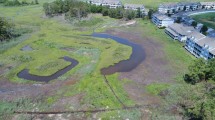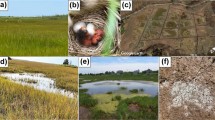Abstract
The paper outlines the evolution of an Australian form of Open Marsh Water Management (OMWM) called runnelling which was implemented in relatively pristine saltmarshes. Runnelling involves shallow channels and was distinguished from OMWM which involves ditching. Both methods aim to conserve tidal hydrology. The core research covers 28 years of research on the original experimental site (Coomera Island, Queensland), in routine monitoring and impact assessments that were made periodically. It also introduces and incorporates information from associated research. This includes effects of runnelling on non-target aspects—snails and crabs. Emerging issues during the course of the longer-term research included the risk of mobilising acid sulfates and of mangrove encroachment into the saltmarsh. As well, use of the data was extended to retrofit it to address broader questions about saltmarsh processes and how to identify them. That identified progressive changes at the Coomera site, and so a further query was whether the system showed signs of approaching a tipping point. In summary, there were some identifiable effects of runnelling in all parts of the research. These were mostly related to the increased wetness near runnels, as flooding by tides would occur at tides up to 0.30 m lower than the pre-runnelling situation. The increased wetness was related to plants, snails and crabs. From a mosquito management perspective the method was successful. From an environmental perspective the environmental changes were only very close to runnels (within 10 m). The overall changes at the experimental site were consistent with other changes in eastern Australia, especially of mangrove encroachment into saltmarshes. Once the runnelling method appeared to manage mosquitoes without damaging wetland values it was adopted widely throughout south east Queensland, encouraged by the positive attitude of permitting agencies, but longer-term evaluation was hindered by lack of relevant records.


Similar content being viewed by others
References
Alsemgeest GP, Dale PER, Alsemgeest DH (2005) Evaluating the risk of potential acid sulfate soils and habitat modification for mosquito control (runneling) in coastal salt marshes: Comparing methods and managing the risk. Environ Manage 36:152–161
Australian Government (2020) National Communicable Diseases Surveillance System, Summary tables. Australian Government, Australia
Breitfuss M (2003a) Effects of habitat modification for mosquito control on non target organisms in intertidal wetlands. PhD, Griffith University
Breitfuss MJ (2003b) Defining the characteristics of burrows to better estimate abundance of the grapsid crab, Helograpsus haswellianus (Decapoda, Grapsidae), on east Australian saltmarsh. Crustaceana 76:499–507
Breitfuss M, Connolly R, Dale P (2003) Mangrove distribution and mosquito control: transport of Avicennia marina propagules by mosquito-control runnels in southeast Queensland saltmarshes. Estuar Coast Shelf Sci 56:573–579
Breitfuss MJ, Connolly RM, Dale PER (2004b) Densities and aperture sizes of burrows constructed by Helograpsus haswellianus (Decapoda: Varunidae) in saltmarshes with and without mosquito-control runnels. Wetlands 24:14–22
Breitfuss M, Chapman HF, Dale PER, Thomas P (2004b) Influence of saltmarsh habitat modification for mosquito control on shore crab populations in southeast Queensland. Wetlands (australia) 22:1–10
Carlson DB, Dale PER, Kurucz N, Dwyer PG, Knight JM, Whelan PI (2019) Mosquito control and coastal development: how they have co-existed and matured in Florida and Australia. J Amer Mosq Cont Assoc 35:123–134
Dakos V, van Nes EH, Donagelo R, Fort H, Scheffer M (2010) Spatial correlation as leading indicator of catastrophic shifts. Theor Ecol 3:163–174
Dale PER (2008) Assessing impacts of habitat modification on a subtropical salt marsh: 20 years of monitoring. Wetl Ecol Manag 16:77–87
Dale PER, Dale MB (2002) Optimal classification to describe environmental change: pictures from the exposition. Commun Ecol 3:19–29
Dale PT, Dale PER (2016) Environmental change over 28 years in a subtropical salt marsh: optimal classification and pictures from the exposition. Commun Ecol 17:198–204
Dale PER, Hulsman K (1988) To identify impacts in variable systems using anomalour changes: a salt marsh example. Vegetatio 75:27–35
Dale P, Knight JM (2006) Managing salt marshes for mosquito control: impacts of runnelling, Open Marsh Water Management and grid-ditching in sub-tropical Australia. Wetl Ecol Manag 14:211–220
Dale P, Knight J (2012) Managing mosquitoes without destroying wetlands:an eastern Australian approach. Wetl Ecol Manag 20:233–242. https://doi.org/10.1007/s11273-012-9262-6
Dale PER, Hulsman K, Chandica AL (1986a) Classification of refectance on colour infrared aerial photgraphs and sub-tropical salt-marsh vegetation types. Int J Remote Sens 7:1783–1788
Dale PER, Hulsman K, Harrison D, Congdon B (1986b) Distribution of the immature stages of Aedes vigilax on a coastal salt-marsh in South East Queensland. Aust J Ecol 11:269–278
Dale PER, Dale PT, Hulsman K, Kay BH (1993) Runnelling to control salt-marsh mosquitos - long-term efficacy and environmental impacts. J Am Mosquito Contr 9:174–181
Dale PER, Chapman H, Brown MD, Ritchie SA, Knight J, Kay BH (2002) Does habitat modification affect oviposition by the salt marsh mosquito, Ochlerotatus vigilax (Skuse) (Diptera: Culicidae)? Aust J of Entomol 41:49–54
Dale PER, Carlson DB, Easton C (2008a) 4 degrees of latitude: mosquito control on the “right’” coasts of Florida and Australia. J Am Mosq Cont Assoc 24:427–437
Dale PER, Knight J, Kay BH, Chapman H, Ritchie SA, Brown MD (2008b) Habitat characteristics and eggshell distribution of the salt marsh mosquito, Aedes vigilax, in marshes in subtropical eastern Australia. J Insect Sci 8:1–8. https://doi.org/10.1673/031.008.2501
Dale P, Eslami-Andargoli L, Knight J (2013) The impact of encroachment of mangroves into saltmarshes on saltwater mosquito habitats. J Vector Ecol 38:330–338
Dale PER, Knight JM, Daniels P (2018) Using present value as a simple approach to compare mosquito larval control methods. J Am Mosquito Contr 34:25–33
Dear S-E, Ahern CR, O’Brien LE, Dobos SK, McElnea AE, Moore NG, Watling KM (2014) Queensland acid sulfate soil technical manual: soil management guidelines. Queensland Government, Brisbane
Easton C (1989) The trouble with the Tweed. Chris Yu, Surry Hills
Easton C, Marshall A (2000) Control of acidic drain-water-breeding mosquitoes in New South Wales, Australia, by installing controlled leakage holes in tidal flap gates. J Am Mosquito Contr 16:19–21
Eslami- Andargoli L, Dale PER, Sipe N, Chaseling J (2009) Mangrove expansion and rainfall patterns in Moreton Bay, southeast Queensland, Australia. Estuar Coast Shelf Sci 85:292–298
Eslami-Andargoli L, Dale PER, Sipe N, Chaseling J (2010) Local and landscape effects on spatial patterns of mangrove forest during wetter and drier periods: Moreton Bay, Southeast Queensland, Australia. Estuar Coast Shelf Sci 89:53–61
Eslami-Andergoli L, Dale PER, Knight JM, McCallum H (2015) Approaching tipping points: a focussed review of indicators and relevance to managing intertidal ecosystems. Wetl Ecol Manag 23:791–802. https://doi.org/10.1007/s11273-014-9352-8
Hulsman K, Dale PER, Kay BH (1989) The runneling method of habitat modification - an environment-focused tool for salt-marsh mosquito management. J Am Mosquito Contr 5:226–234
Jones J, Dale PER, Chandica AL, Breitfuss MJ (2004) Changes in the distribution of the grey mangrove Avicennia marina (Forsk.) using large scale aerial color infrared photographs: are the changes related to habitat modification for mosquito control? Estuar Coast Shelf Sci 61:45–54
Kasarapu P, Allison L (2015) Minimum message length estimation of mixtures of multivariate Gaussian and von Mises-Fisher distributions. Mach Learn 100:333–378
Kelleway JJ, Cavanaugh K, Rogers K, Feller IC, Ens E, Doughty C, Saintilan N (2017) Review of the ecosystem service implications of mangrove encroachment into salt marshes. Global Change Biol 23:3967–3983. https://doi.org/10.1111/gcb.13727
Knight J, Marx S, Dale P (2021) An Assessment of Runnelling as a Form of Mosquito Control in Saltmarsh: Efficacy, Impacts and Management. Wetl Ecol Manag
Knight J, Dale P, Dwyer P, Maex S (2017a) A conceptual approach to integrate management of ecosystem service and disservice in coastal wetlands. AIMS Environ Sci 4:431–442. https://doi.org/10.3934/environsci.2017.3.431
Knight JM, Eslami-Andergoli L, Dale P, Fry B (2017b) State changes in tropical intertidal systems: a palaeo-ecological approach. J Coastal Res 33:208–217
Latchford JA (1997) The effectiveness and environmental impacts of runnelling, a mosquito control technique. PhD, Murdoch University, Perth, Western Australia
Oliver T, Rogers K, Chafer C, Woodroffe C (2012) Measuring, mapping and modellig: an integrated approach to the management of mangrove and saltmarsh in the Minnamurra River estuary, southeast Australia. Wetl Ecol Manag 20:353–371
Ramsar (2015) The Fourth Ramsar Strategic Plan 2016–2024. https://www.ramsar.org/the-ramsar-strategic-plan-2016-24 accessed Jan 3 2021
Ratnayake J (2006) The valuation of social and economic costs of mosquito – transmitted Ross River virus. PhD, Griffith University
Rogers K, Saintilan N, Woodroffe CD (2014) Surface elevation change and vegetation distribution dynamics in a subtropical coastal wetland: implications for coastal wetland response to climate change Estuarine Coastal and Shelf. Science 149:46–56. https://doi.org/10.1016/j.ecss.2014.07.009
Saffigna PG, Dale PER (1999) Acid sulfate soils in intertidal mosquito breeding habitats and implications for habitat modification. J Am Mosquito Assoc 15:520–525
Saffigna PG, Holland G, Dale PER, Mulder G (1997) Impact of acid sulfate soils on habitat modification for mosquito control in coastal Australia. Arbovir Res Australia 7:252–257
Saintilan N, Williams RJ (1999) Mangrove transgression into saltmarsh environments in south-east Australia. Global Ecol Biogeogr 8:117–124
Saintilan N, Rogers K, Kelleway JJ, Ens E, Sloane DR (2019) Climate change impacts on the coastal wetlands of Australia. Wetlands 39:1145–1154. https://doi.org/10.1007/s13157-018-1016-7
Scheffer MBJ, Brock WA (2009) Early-warning signals for critical transitions. Nature 461:53–59
Shisler JK, Schulze TL (1985) Methods for evaluation of costs associated with permanent and temporary control methods for salt-marsh mosquito abatement. J Am Mosquito Contr 1:164–168
Swei A, Couper LI, Coffey LL, Kapan D, Bennett S (2020) Patterns, drivers, and challenges of vector-borne disease emergence. Vector-Borne Zoonot 20:159–170
Wallace C (2005) Statistical and Inductive Inference by Minimum Message Length. Springer, New York
Whitt AA, Coleman R, Lovelock CE, Gillies C, Lerodiaconou D, Liyanapathirana M, Macreadie PI (2020) March of the mangroves: drivers of encroachment into southern temperate saltmarsh. Estuar Coast Shelf Sci 240:9. https://doi.org/10.1016/j.ecss.2020.106776
Acknowledgements
We thank the reviewers for their constructive comments. We also thank the many people, too numerous to name, from diverse areas and roles who have assisted in the research and all its components over many years.
Funding
Not applicable.
Author information
Authors and Affiliations
Contributions
All authors were involved in the original research and have contributed directly to the paper.
Corresponding author
Ethics declarations
Conflict of interest
There are no conflicts of interest.
Consent to participate
All authors have agreed to participate.
Consent for publication
All authors have agreed to publication.
Additional information
Publisher's Note
Springer Nature remains neutral with regard to jurisdictional claims in published maps and institutional affiliations.
Rights and permissions
About this article
Cite this article
Dale, P., Knight, J. & Breitfuss, M. An Australian form of Open Marsh Water Management (runnelling): long term monitoring, ancillary and extended research. Wetlands Ecol Manage 30, 1023–1032 (2022). https://doi.org/10.1007/s11273-021-09806-8
Received:
Accepted:
Published:
Issue Date:
DOI: https://doi.org/10.1007/s11273-021-09806-8




